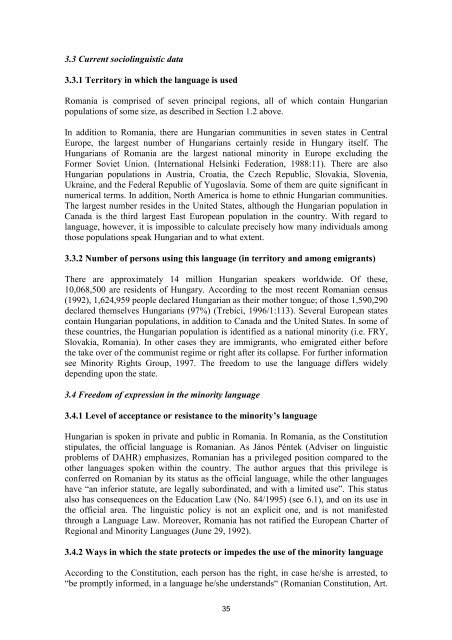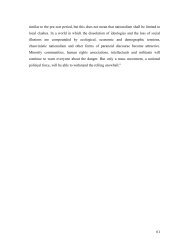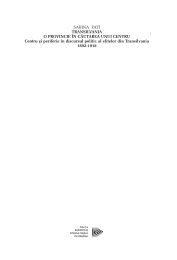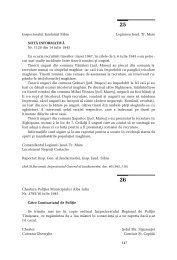Southeast Europe
Southeast Europe
Southeast Europe
Create successful ePaper yourself
Turn your PDF publications into a flip-book with our unique Google optimized e-Paper software.
3.3 Current sociolinguistic data<br />
3.3.1 Territory in which the language is used<br />
Romania is comprised of seven principal regions, all of which contain Hungarian<br />
populations of some size, as described in Section 1.2 above.<br />
In addition to Romania, there are Hungarian communities in seven states in Central<br />
<strong>Europe</strong>, the largest number of Hungarians certainly reside in Hungary itself. The<br />
Hungarians of Romania are the largest national minority in <strong>Europe</strong> excluding the<br />
Former Soviet Union. (International Helsinki Federation, 1988:11). There are also<br />
Hungarian populations in Austria, Croatia, the Czech Republic, Slovakia, Slovenia,<br />
Ukraine, and the Federal Republic of Yugoslavia. Some of them are quite significant in<br />
numerical terms. In addition, North America is home to ethnic Hungarian communities.<br />
The largest number resides in the United States, although the Hungarian population in<br />
Canada is the third largest East <strong>Europe</strong>an population in the country. With regard to<br />
language, however, it is impossible to calculate precisely how many individuals among<br />
those populations speak Hungarian and to what extent.<br />
3.3.2 Number of persons using this language (in territory and among emigrants)<br />
There are approximately 14 million Hungarian speakers worldwide. Of these,<br />
10,068,500 are residents of Hungary. According to the most recent Romanian census<br />
(1992), 1,624,959 people declared Hungarian as their mother tongue; of those 1,590,290<br />
declared themselves Hungarians (97%) (Trebici, 1996/1:113). Several <strong>Europe</strong>an states<br />
contain Hungarian populations, in addition to Canada and the United States. In some of<br />
these countries, the Hungarian population is identified as a national minority (i.e. FRY,<br />
Slovakia, Romania). In other cases they are immigrants, who emigrated either before<br />
the take over of the communist regime or right after its collapse. For further information<br />
see Minority Rights Group, 1997. The freedom to use the language differs widely<br />
depending upon the state.<br />
3.4 Freedom of expression in the minority language<br />
3.4.1 Level of acceptance or resistance to the minority’s language<br />
Hungarian is spoken in private and public in Romania. In Romania, as the Constitution<br />
stipulates, the official language is Romanian. As János Péntek (Adviser on linguistic<br />
problems of DAHR) emphasizes, Romanian has a privileged position compared to the<br />
other languages spoken within the country. The author argues that this privilege is<br />
conferred on Romanian by its status as the official language, while the other languages<br />
have “an inferior statute, are legally subordinated, and with a limited use”. This status<br />
also has consequences on the Education Law (No. 84/1995) (see 6.1), and on its use in<br />
the official area. The linguistic policy is not an explicit one, and is not manifested<br />
through a Language Law. Moreover, Romania has not ratified the <strong>Europe</strong>an Charter of<br />
Regional and Minority Languages (June 29, 1992).<br />
3.4.2 Ways in which the state protects or impedes the use of the minority language<br />
According to the Constitution, each person has the right, in case he/she is arrested, to<br />
“be promptly informed, in a language he/she understands“ (Romanian Constitution, Art.<br />
35









